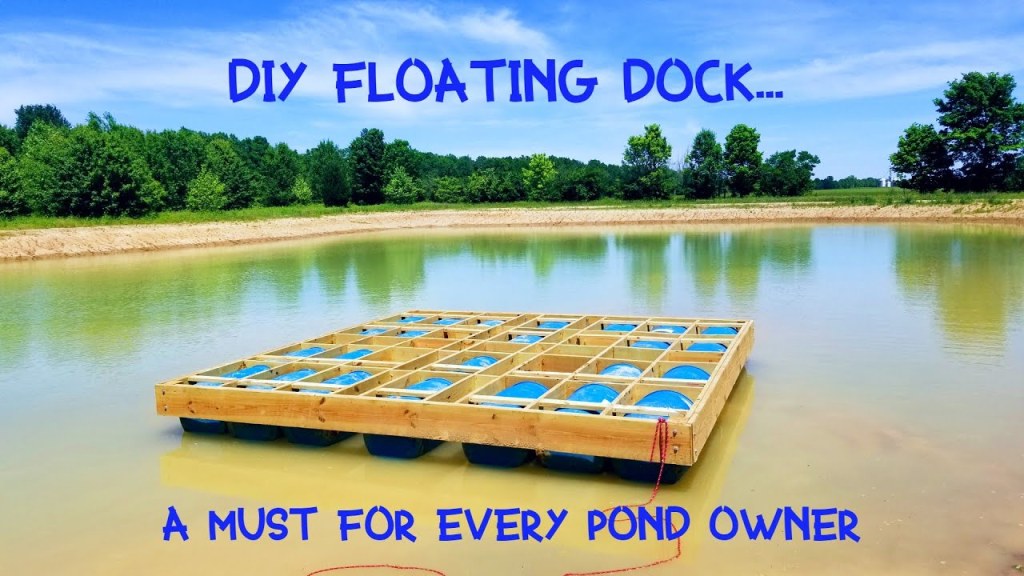Discover The Ultimate Guide: The Cheapest Way To Build A Floating Dock – Unveiling Effective DIY Techniques For Budget-friendly Waterfront Construction!
Cheapest Way to Build a Floating Dock
Introduction
Welcome, Shopper! Are you looking for an affordable way to build a floating dock? Look no further! In this article, we will explore the cheapest way to build a floating dock and provide you with all the information you need to get started. Building a floating dock can be a cost-effective solution for creating a recreational or functional space on the water. Whether you want to enjoy fishing, boating, or simply relax by the water, a floating dock offers a versatile and budget-friendly option. So, let’s dive in and discover the best approach to constructing a floating dock without breaking the bank!
1 Picture Gallery: Discover The Ultimate Guide: The Cheapest Way To Build A Floating Dock – Unveiling Effective DIY Techniques For Budget-friendly Waterfront Construction!

The Basics of Building a Floating Dock
Before we delve into the specifics, let’s start with the basics of building a floating dock. A floating dock is a platform that is buoyant and designed to be assembled on the water. It typically consists of floating modules or barrels that provide the necessary buoyancy. These modules are connected to form a stable and secure platform. The construction process involves selecting the right materials, determining the dimensions, and assembling the dock. By following the cheapest method, you can save money without compromising on the quality and functionality of your floating dock.
What is the Cheapest Way to Build a Floating Dock?

Image Source: ytimg.com
🔎 To find the cheapest way to build a floating dock, you need to consider several factors such as materials, design, and installation. Here are some cost-effective options:
1. Use Recycled Materials
♻️ One way to save costs is to use recycled materials for your floating dock. Look for reclaimed wood, plastic barrels, or even old pallets that can be repurposed. Not only will this help you reduce expenses, but it is also an environmentally friendly choice.
2. Opt for Modular Dock Systems
🧩 Modular dock systems are pre-designed and pre-fabricated sections that can be easily assembled. These systems often come with detailed instructions, making the installation process straightforward. Additionally, modular dock systems are cost-effective as they eliminate the need for custom designs and extensive construction.
3. Choose Affordable Decking Materials
💲 Decking materials can significantly impact the cost of your floating dock. Consider using cost-effective options such as pressure-treated lumber, composite decking, or even recycled plastic lumber. These materials offer durability and require minimal maintenance, making them ideal for budget-conscious builders.
4. DIY Assembly
🔧 To further minimize costs, opt for a do-it-yourself (DIY) approach. Building a floating dock doesn’t necessarily require professional help. With the right tools and instructions, you can assemble it yourself, saving money on labor costs.
5. Local Suppliers and Second-Hand Bargains
🌍 Look for local suppliers who offer competitive prices on materials. Additionally, explore second-hand options for components such as barrels, floats, or connectors. You may find great bargains that significantly reduce the overall cost of your floating dock.
6. Simple Design
📐 Opting for a straightforward and simple design can help keep costs down. Avoid complex shapes or unnecessary features that require additional materials and labor. Stick to the basics, and you’ll have an affordable floating dock that meets your needs.
Who Can Benefit from a Floating Dock?
🤔 Floating docks are versatile structures that can benefit various individuals and organizations. Here are a few examples:
1. Waterfront Property Owners
🏡 If you own waterfront property, a floating dock can enhance your recreational activities and increase the value of your property. It provides a convenient access point for boating, fishing, and swimming.
2. Boating Enthusiasts
⛵️ Whether you own a motorboat, sailboat, or kayak, a floating dock is a convenient solution for mooring your vessel. It offers a stable and secure platform for boarding and disembarking.
3. Commercial Establishments
🏨 Resorts, hotels, and waterfront restaurants can benefit from a floating dock to attract guests and provide a memorable experience. It offers a unique space for water-based activities and entertainment.
4. Community Docks
👨👩👧👦 Floating docks can be utilized by communities and municipalities to enhance public spaces. They can provide access to fishing spots, swimming areas, or simply a place to gather and enjoy the waterfront.
5. Marinas and Yacht Clubs
⚓️ Marinas and yacht clubs can expand their dockage capacity by incorporating floating docks. This allows them to accommodate more boats and provide additional amenities for their members.
When to Build a Floating Dock
⏰ The timing for building a floating dock depends on various factors, including weather conditions and personal requirements. Here are a few considerations:
1. Off-Season
🍂 If you live in an area with distinct seasons, building a floating dock during the off-season can be advantageous. This allows you to take advantage of lower prices for materials, as well as potentially hire contractors at a reduced rate due to decreased demand.
2. Before Boating Season
⛵️ To ensure your floating dock is ready when boating season begins, plan your construction accordingly. Aim to have it completed a few weeks before the season starts, allowing enough time for any adjustments or modifications.
3. Consider Weather Patterns
🌦 If your region experiences extreme weather conditions during certain times of the year, take that into account when planning your floating dock construction. You may need to reinforce the dock or choose materials that can withstand the local climate.
Where to Build a Floating Dock
🗺 Choosing the right location for your floating dock is crucial for its functionality and longevity. Consider the following factors:
1. Local Regulations
📜 Check with your local authorities regarding any regulations or permits required for building a floating dock. Each jurisdiction may have specific rules regarding waterfront structures.
2. Water Depth
📏 Ensure that the water depth is suitable for your floating dock. Consult with professionals, such as marine engineers or surveyors, to determine the optimal location based on the water depth and conditions.
3. Accessibility
🚗 Consider how easily you can access the floating dock from land. Ensure there is a safe and convenient path for transporting materials during construction and for individuals to access the dock once it is completed.
4. Surroundings
🌳 Take into account the surroundings of the proposed location. Consider factors such as wind patterns, wave action, and any potential obstacles that could affect the stability and safety of your floating dock.
Why Choose the Cheapest Way to Build a Floating Dock?
❓ There are several reasons why opting for the cheapest way to build a floating dock makes sense:
1. Cost Savings
💰 By choosing cost-effective materials and methods, you can save a significant amount of money on your floating dock project. This allows you to allocate your budget towards other aspects such as maintenance, accessories, or additional features.
2. Accessibility
🚤 Building a floating dock on a budget ensures that it is accessible to a wider range of individuals, regardless of their financial means. It promotes inclusivity and provides opportunities for everyone to enjoy the benefits of being on the water.
3. DIY Satisfaction
🔨 Building your own floating dock can be a rewarding experience. It gives you a sense of accomplishment and allows you to customize the dock according to your specific needs and preferences.
How to Build a Floating Dock
🛠 Building a floating dock requires careful planning and execution. Here is a general step-by-step guide:
1. Research and Design
📚 Start by researching various dock designs and gathering the necessary information. Consider factors such as water conditions, intended use, and available materials. Sketch out your design and determine the dimensions.
2. Gather Materials
📦 Once you have finalized your design, gather all the required materials. This may include lumber, barrels, connectors, and any additional hardware.
3. Prepare the Site
⏳ Clear the area where you plan to build your floating dock. Remove any obstructions, vegetation, or debris. Ensure the site is level and ready for construction.
4. Assemble the Floating Modules
🔩 Assemble the floating modules or barrels according to the manufacturer’s instructions. Ensure they are securely connected to form a stable base.
5. Build the Decking
🛠 Construct the decking by attaching the chosen materials to the floating modules. Follow the design you created, ensuring everything is level and secure.
6. Install Additional Features
🌅 Depending on your needs, install any additional features such as handrails, cleats, or ladders. These enhance the functionality and safety of your floating dock.
7. Launch and Test
⛴ Once the construction is complete, carefully launch your floating dock into the water. Test its stability and make any necessary adjustments to ensure it meets your expectations.
Advantages and Disadvantages of Building a Floating Dock
👍 Let’s explore the advantages and disadvantages of building a floating dock:
Advantages
📌 1. Versatility: A floating dock can be easily moved or reconfigured to suit your changing needs.
📌 2. Accessibility: It provides a convenient and safe access point to the water for various activities.
📌 3. Cost-Effective: Building a floating dock can be more affordable compared to a permanent structure.
📌 4. Easy Maintenance: Floating docks require minimal maintenance, reducing your long-term costs.
📌 5. Environmentally Friendly: Opting for recycled materials promotes sustainability and reduces waste.
Disadvantages
📌 1. Vulnerability to Rough Weather: Floating docks may be less stable during extreme weather conditions such as storms.
📌 2. Limited Size: The size of a floating dock is typically smaller compared to a fixed structure due to buoyancy limitations.
📌 3. Regular Inspections: Floating docks should be inspected regularly to ensure they remain in good condition and safe to use.
📌 4. Potential Damage from Marine Life: The constant exposure to water may lead to damage from marine organisms such as algae or barnacles.
📌 5. Legal Restrictions: Always check local regulations and obtain any necessary permits before building a floating dock.
Frequently Asked Questions (FAQ)
1. Can I use any type of wood for the decking?
🔨 While you can use various types of wood for the decking, it is essential to choose a material that can withstand constant exposure to water. Pressure-treated lumber or composite decking are popular choices due to their durability.
2. How long does it take to build a floating dock?
⏰ The construction time for a floating dock depends on several factors such as size, complexity, and the number of people working on the project. It can take anywhere from a few days to a few weeks to complete.
3. Do I need a permit to build a floating dock?
📜 Permit requirements vary depending on your location and local regulations. It is crucial to check with your local authorities to determine if you need a permit before starting construction.
4. Can I add accessories to my floating dock?
🎣 Absolutely! You can customize your floating dock by adding accessories such as benches, fishing rod holders, or even a small roof for shade. Just ensure that any additional features are securely attached and won’t compromise the stability of the dock.
5. How often should I inspect my floating dock?
🔍 Regular inspections are essential to ensure the safety and longevity of your floating dock. Aim to inspect it at least once a year, checking for any signs of wear, damage, or loose connections. Additionally, perform a thorough inspection after any severe weather events.
Conclusion
🏗 Building a floating dock doesn’t have to be expensive. By following the cheapest way to construct a floating dock, you can save money while still enjoying all the benefits it offers. Remember to research, plan, and gather the necessary materials before starting your project. Be mindful of local regulations and choose a suitable location for your floating dock. With proper construction and regular maintenance, your affordable floating dock will provide you with years of enjoyment on the water!
Disclaimer: The information provided in this article is for educational purposes only. Always consult with professionals and adhere to local regulations and safety guidelines when building a floating dock.
This post topic: Shopping



